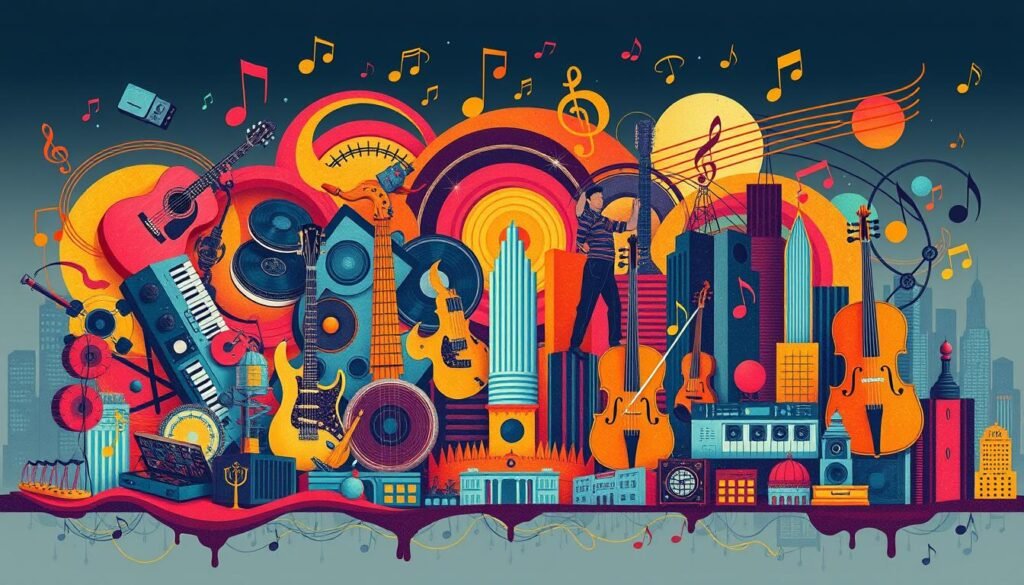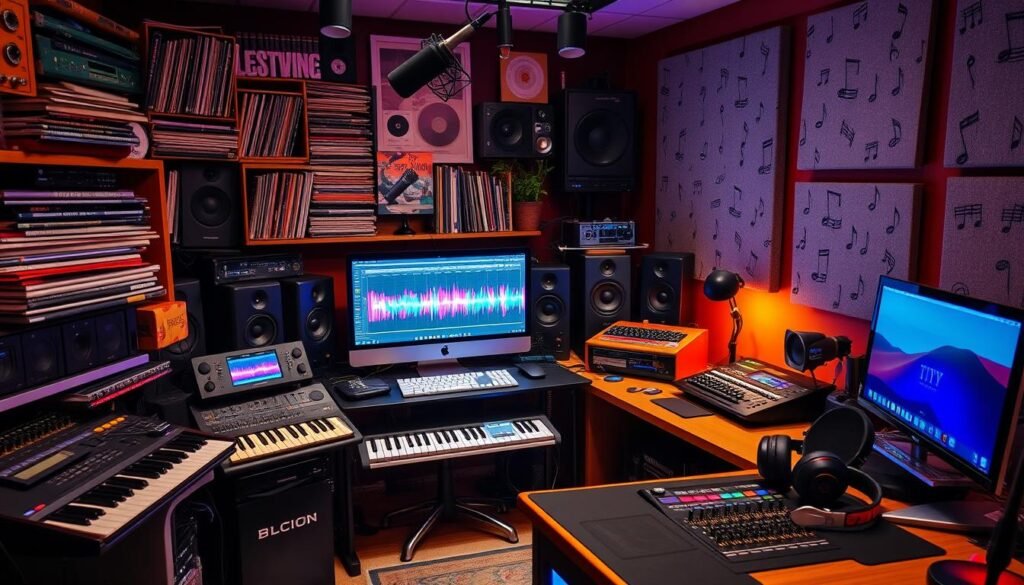History Of Music is a universal part of human culture, found in every society. Its beginnings are a topic of much debate. Some believe music came from the development of language and emotions.
The oldest signs of music date back to about 40,000 years ago. This is when bone flutes and other instruments from the Upper Paleolithic period were found. As civilizations like China, Egypt, Greece, India, and Persia grew, they each developed their own music styles. These styles were often shaped by their religions and cultures.
Also Read: Instrumental Music Benefits For Studying Effectively
Over time, music has changed a lot. This change came from new musical notations and instruments, and also from technology. From the sacred songs of early Christians and Muslims to the rise of Western classical music, music’s history is full of different cultures and artistic expressions.
Key Takeaways
- Music has been a cultural universal, present in every known society throughout history.
- The origins of music are highly debated, with theories linking its development to language and emotional expression.
- Earliest evidence of prehistoric musical expression dates back to around 40,000 years ago.
- Ancient civilizations cultivated distinct musical traditions, often influenced by religious and cultural factors.
- The evolution of music has been shaped by various factors, including the development of musical notation and instruments, as well as technological advancements.
The Origins and Cultural Significance of Music
Music’s origins are still debated by experts. Some think it was used for attracting mates, while others see it as a tool for organizing work and building communities. Early humans likely used voices, body beats, and simple tools to make music.
Also Read: How To Learn Music Online Effectively?
Early Human Musical Expression
Our ancient ancestors enjoyed music, too. The oldest known instruments, like bone flutes, are about 40,000 years old. Finds like the Divje Babe Flute from Slovenia and bone flutes from Germany show our ancestors’ musical talent.
Music as a Cultural Universal
Music is everywhere, in every culture. It meets basic human needs like expressing feelings, bringing people together, and sharing stories. This shows music’s deep importance in our lives.
Prehistoric Musical Instruments
Many ancient instruments have been found, giving us a peek into early human music. These include bone flutes, drums, and other sounds. They prove our ancestors loved music and it was a big part of their lives.
| Instrument | Location | Estimated Age |
|---|---|---|
| Divje Babe Flute | Slovenia | c. 40,000 BP |
| Bone Flutes | Geissenklösterle, Germany | c. 35,000 BP |
Discoveries of ancient instruments show music’s long history with humans. They highlight music’s role in our evolution and its universal appeal.
Also Read: How To Find The Best Music For Studying?
History Of Music Through Ancient Civilizations

The ancient world saw many musical traditions grow. China, Egypt, Greece, and India each had their own music. These cultures shared ideas and music along the Silk Road.
In ancient China, the guqin zither is over 3,000 years old. The Bianzhong of Marquis Yi of Zeng, from the 5th century BCE, shows China’s musical skill.
The ancient Egyptians loved music, with flutes, lutes, and harps. Their oldest instruments date back to the Old Kingdom era, from 2575 BCE to 2134 BCE.
| Ancient Civilization | Musical Instruments | Time Period |
|---|---|---|
| Ancient China | Guqin (seven-stringed zither) | Around 3,000 years old |
| Ancient Egypt | Flutes, clarinet-like reed instruments, lutes, harps | 2575 BCE to 2134 BCE (Old Kingdom era) |
| Mesopotamia | Harps | Around 2750 BCE |
| Ancient India | Samaveda hymns, Natya Shastra treatise | Samaveda hymns dating back to around 2000 BCE; Natya Shastra written between 200 BCE and 200 CE |
| Ancient Greece | Flutes, kithara (lyre/harp-like instrument), pan pipes, double pipes/flutes | Pythagorean harmonies and development of modes/scales |
In Mesopotamia, early melodies are found in cuneiform tablets from 2000 BCE. Leonard Woolley found harp pieces from 2750 BCE in Ur.
Also Read: How Music Career Coaching Can Boost Your Success?
The ancient Indian music is rich, with the Samaveda hymns from around 2000 BCE. The Natya Shastra, written between 200 BCE and 200 CE, has 36,000 slokas.
The ancient Greeks had a system of musical notation. Their music was influenced by Pythagorean harmonies and later the Roman Empire.
These ancient civilizations developed unique musical cultures. They also shared music and ideas along the Silk Road. This sharing influenced music in China, Japan, and Korea.
The Evolution of Religious and Sacred Music
The history of sacred music is closely tied to the growth of religions around the world. Religions have greatly influenced music across cultures. For example, the Vedas shaped Indian classical music, while Confucian texts influenced Chinese music.
Also Read: How To Choose The Right Music University For Composers?
Impact of Religion on Musical Development
The early Christian Church was key in shaping Western classical music. Chant was the main music form before Constantine. Church leaders favored it, seeing it as sacred.
As the Church grew, chants evolved. Singers started using longer, more complex melodies. This was like “singing in tongues.”
Sacred Music Traditions Worldwide
Everywhere, sacred music has its own special instruments, voices, and styles. In the Islamic world, music became central in Persia and Arab regions after the 7th century. The Moravian Church in America used both German and English in their services, keeping their music alive.
Musical Notation in Religious Practices
The need for musical notation grew from religious needs. It helped preserve sacred music. The first American music book by a native composer was “New England Psalm Singer” by William Billings in 1770.
The Moravian Church also left a mark. Composer Johann Friedrich Peter wrote secular music in 1789, showing the church’s musical range.
| Year | Event |
|---|---|
| 1640 | The first book published in the American colonies was “The Whole Booke of Psalmes Faithfully Translated into English Metre,” commonly known as the “Bay Psalm Book.” |
| 1698 | The Bay Psalm Book only incorporated printed music in its ninth edition. |
| 1770 | The first publication of sacred music composed entirely by a native-born American was William Billings’s “New England Psalm Singer.” |
| 1789 | Moravian composer Johann Friedrich Peter of Salem, North Carolina, wrote secular chamber music in the form of string quintets. |
The journey of sacred music has been deeply influenced by religious influence. This has led to many traditions and the creation of musical notation systems. These systems help pass on sacred music to future generations.
Classical Music Traditions and Development

Western classical music has a rich history, starting with early Christian church music. It has grown into the diverse genres we love today. Over centuries, from medieval to modern times, each era brought new developments and famous composers.
The rise of polyphony, around 1000 AD, was a major innovation. It allowed for complex and expressive music. Staff notation and new instrumental forms like symphonies and operas also shaped classical music.
Composers like Bach, Mozart, and Beethoven have greatly influenced classical music. Their works are key in concert halls and music education. They help us understand the depth and beauty of Western classical music.
Today, classical music education teaches about different periods and styles. It prepares students to appreciate the historical and artistic value of this genre. From Baroque grandeur to Romantic emotion, classical music continues to captivate audiences globally.
“Music is the universal language of mankind.” – Henry Wadsworth Longfellow
The Birth and Evolution of Popular Music Genres

The music world has changed a lot over the years. New music styles have come up, like country and bluegrass from folk music. Jazz, rock and roll, and their many types have changed music a lot in the 20th century.
From Folk to Contemporary Styles
Rock and roll started in the 1950s and grew into punk and heavy metal. The 1990s saw the rise of alternative rock. Jazz evolved from big band to bebop and modal jazz. Hip-hop, starting in the 1970s in the Bronx, mixes music, rapping, DJing, breakdancing, and graffiti.
The Rise of Electronic Music
In the late 20th century, electronic music became popular. Genres like techno, house, and trance emerged. Artists like Daft Punk and Deadmau5 led this change, thanks to new technology.
Global Music Fusion
Today, music from all over the world mixes together. This global music fusion creates new sounds. It makes music richer and more varied, blending different cultures.
| Genre | Origins | Prominent Artists |
|---|---|---|
| Rock and Roll | Emerged in the 1950s, with subgenres like punk and heavy metal | Elvis Presley, Chuck Berry, Jimi Hendrix, Nirvana |
| Jazz | Originated in the late 19th and early 20th centuries, with subgenres like big band, bebop, and modal jazz | Louis Armstrong, Duke Ellington, Miles Davis, John Coltrane |
| Hip-Hop | Emerged in the 1970s from the Bronx, with elements of music, rapping, DJing, breakdancing, and graffiti | DJ Kool Herc, Grandmaster Flash, Run-DMC, Nas |
| Electronic Music | Began in the late 20th century, with subgenres like techno, house, and trance | Daft Punk, Deadmau5, Skrillex, Marshmello |
“Music has the power to transcend boundaries, uniting people from diverse backgrounds and cultures.”
Technological Advancements in Music Production

The world of music production has changed a lot over the last 100 years. It started with the phonograph in 1877 and moved to digital audio workstations. This change has made music creation easier and more accessible.
Back then, music was made with reel-to-reel tape recorders and analog synthesizers. Famous microphones like the Neumann U 47 helped capture great sounds. Pioneers like Wendy Carlos used Korg synthesizers to create new sounds.
The arrival of digital recording changed everything. The Yamaha DX7 digital synthesizer by Roland Corporation was a big step forward. Digital audio workstations made editing and mixing easier, opening music creation to more people. Today, digital streaming services give us access to a wide range of music.
Mobile technology is set to change music production even more. It will make music tools easier to use and encourage teamwork. Even with digital tools, the need for skilled sound engineers and audio experts is still high. They help make music sound its best.
“The democratization of music creation has been facilitated by the advancements in digital music production technology.”
Also Read: Music Career Goals: A Guide To Long Term Success
Conclusion
The history of music shows how culture, society, and technology have changed over time. From ancient bone flutes to today’s digital streams, music has always been key to human expression. Knowing this history helps us appreciate the many musical traditions that shape our world.
Looking ahead, music will likely become even more accessible. This raises interesting questions about its value and how we consume it today. With new tech, music might bring people from all over the world closer together. This could lead to even more exciting musical collaborations and cultural exchanges.
The story of music is one of perseverance, creativity, and our deep need to share sounds. By diving into this history, we learn more about music’s big impact on culture and our lives. It shows how music has always been a powerful way for us to connect and express ourselves.
FAQs
Q: What is the significance of the renaissance in music history?
A: The renaissance was a pivotal period in music history characterized by the revival of interest in the arts and humanism. It saw the emergence of polyphonic music and the development of music notation, allowing for more complex musical forms and the spread of different musical traditions across Europe.
Q: How did the transition from the medieval period to the renaissance influence musical traditions?
A: The transition marked a shift from Gregorian chant and monophonic textures of the medieval period to the rich, polyphonic styles of the renaissance. This evolution allowed for greater expression and complexity in vocal and instrumental music, paving the way for later developments in music theory.
Q: What are some key composers from the classical period, and how did they contribute to music history?
A: Key composers from the classical period include Joseph Haydn, Johann Sebastian Bach, and Wolfgang Amadeus Mozart. They contributed to music history by establishing forms of music such as sonatas, symphonies, and concertos, which greatly influenced the trajectory of western music.
Q: What role did sacred and secular music play during the baroque era?
A: During the baroque era, both sacred and secular music flourished. Composers like Handel and Vivaldi produced significant works for the Roman Catholic Church as well as for public concerts. This dual focus enriched the musical landscape and contributed to the development of distinct musical genres.
Q: How did the romantic period change the perception of instrumental music?
A: The romantic period shifted the perception of instrumental music by emphasizing emotional expression and individualism. Composers like Chopin and Schumann focused on piano music and expanded the use of orchestration, creating more personal and evocative works that resonated with audiences.
Q: What is the impact of recorded music on modern music history?
A: Recorded music revolutionized modern music history by making music widely accessible and allowing for the preservation of musical performances. This development enabled various genres to flourish and led to the globalization of music, influencing both traditional and contemporary music forms.
Q: In what ways has the future of music been shaped by technological advancements?
A: The future of music has been shaped by technological advancements such as digital audio production, streaming services, and social media platforms. These innovations have transformed how music is created, distributed, and consumed, giving rise to new genres and international musical collaborations.
Q: How do different musical forms reflect cultural diversity in music history?
A: Different musical forms, such as indigenous music, traditional music, and court music from various cultures, reflect the cultural diversity in music history. Each form embodies the unique values, beliefs, and histories of its originating culture, contributing to a rich tapestry of global musical traditions.
Q: What are some historical developments in music notation, and how have they affected music?
A: Historical developments in music notation, from neumes in the medieval period to modern staff notation, have greatly affected music by allowing composers to write down their works clearly and precisely. This has facilitated the study and performance of music across generations and cultures, preserving musical history.
Source Links
- https://en.wikipedia.org/wiki/History_of_music
- https://www.loc.gov/collections/moldenhauer-archives/articles-and-essays/guide-to-archives/music-history/
- https://www.mi.edu/in-the-know/musics-historical-influence-ancient-greece-modern-times/
- https://www.britannica.com/art/music
- https://en.wikipedia.org/wiki/Ancient_music
- https://centerstagemusiccenter.com/music-of-the-ancient-world/
- https://www.loc.gov/collections/songs-of-america/articles-and-essays/musical-styles/ritual-and-worship/?fa=language:castilian
- https://blog.adw.org/2017/06/sacred-music-history-complex-might-think/
- https://www.apostolic.edu/the-historical-development-of-sacred-music/
- https://en.wikipedia.org/wiki/Classical_music
- https://www.gramophone.co.uk/features/article/a-brief-history-of-classical-music
- https://www.naxos.com/classicalmusichistory
- https://www.mi.edu/in-the-know/symphony-change-tracing-evolution-music-genres/
- https://guitargetlessons.com/valuables/music-history-timeline/
- https://open.lib.umn.edu/mediaandculture/chapter/6-2-the-evolution-of-popular-music/
- https://thecomposerclass.com/articles/the-evolution-of-music-production-technologies-a-deep-dive-into-the-history-and-development-of-music-production-technologies-from-analog-to-digital
- https://www.jmcacademy.edu.au/news-and-events/news/how-technology-has-changed-music-production/
- https://www.rollingstone.com/music/music-lists/24-inventions-that-changed-music-16471/
- https://academic.oup.com/book/784/chapter/135422387
- https://www.123helpme.com/essay/Conclusion-Of-Music-Essay-PJP58SQBG




